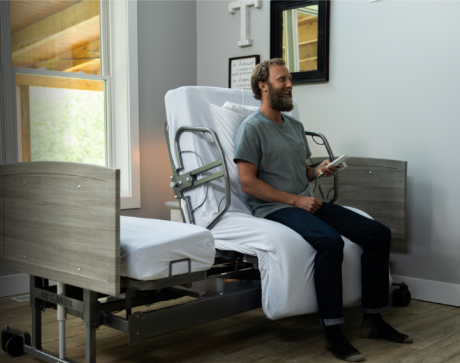




Hospital beds are no longer limited to nursing homes and hospitals. To manage chronic health conditions, many patients require hospital beds at home. They are useful tools for keeping loved ones secure and comfortable during times of illness or recuperation. There are numerous variations available, each with its own set of features. One of the most important decisions is whether to purchase the same bed used in the hospital or a hospital bed adapted for home-usage.
These beds are specifically built to satisfy the demands of patients and hospital employees. For comfort and therapy, the back and knee parts can be adjusted, and the entire bed frame can be elevated and lowered as needed. Upper and lower side rails that are large and bulky are automatically integrated. The controls for adjusting the bed are positioned on the inside and outside of the side rails. Several types of pressure relief mattresses are available, including those with reduced air loss and lateral rotation. Some hospital beds, such as the Hillrom TotalCare, can help the patient transfer to a sitting position during mealtimes.
Home hospital beds contain many of the same features as traditional hospital beds, but they are better suited for those who live at home or in assisted living facilities. Full electric beds offer adjustable back and knee parts and the ability to raise and lower the bed frame. The rotating pivot frame of the Med-Mizer ActiveCare SafeTurn bed allows the patient to be moved from a flat to a seated position at the touch of a button. It also contains a stand assist mechanism that assists the patient in rising and exiting the bed.
The build typically have a basic frame that can handle a 36” x 80” mattress, with larger alternatives available for bariatric patients. The Invacare BAR600 bariatric bed features a 42″ wide sleep surface and can support individuals weighing up to 600 lbs. The Med-Mizer CC803 Retractabed’s frame may be modified to either 39″ or 42″ wide. This gives patients more room to roll over for back rubs or linen changes.
Home hospital beds are made to look as much like regular beds as possible. Sleek designs and diverse forms of head and footboards resemble bedroom furniture and can be incorporated into any decor. Side rails and assist bars are small and take up little room on either side of the bed.
Adjustable high-low beds are specifically intended for people who live at home or in long-term care settings. The Invacare Carroll CS7 Hi-Low bed has a bed frame that is only 7″ above the floor. This is useful for patients who may roll out of bed or attempt to get up without asking for help.
For home hospital beds, a wide range of mattress alternatives is available to provide comfort, redistribute pressure, and maintain the patient’s posture. For incontinent individuals, SaniSnooze mattresses are fluid-resistant and hypoallergenic. MedMattress Care mattresses are made of high-density supportive memory foam and include multiple zones for patients who are at low, moderate, or high risk for pressure sores. For patients who are at high risk of skin disintegration, the powered Span America Protocol mattresses provide alternating pressure and powered flotation treatment alternatives. Before purchasing therapeutic mattresses, patients and caregivers should contact physicians and wound care professionals.
Hospital beds are huge and heavy, and they cannot be disassembled for delivery. Hospital entrances are built to allow 37″ – 40″ wide beds to pass through. When new healthcare beds arrive, they are inspected and scheduled for regular preventative maintenance. Hospitals have teams of biomedical technicians and manufacturer-provided extended service programs. The head and footboards of home hospital beds are designed to be removable from the frame for shipping and installation. Regular healthcare beds cannot be dismantled for delivery and will not fit through 32″ – 36″ wide home entrances. To fit through residential doorways, the entire bed must be turned on its side and placed on a dolly. This can harm the bed structure, electronics, and side rails. The hydraulic mechanism in the Hillrom TotalCare hospital bed should not be turned on its side.
At the time of purchase, refurbished hospital beds could be 10 to 20 years old. They normally come with a one-year warranty that only covers any replacement parts that may be required. The service must be conducted by certified biomedical technicians, and the consumer is responsible for all labor costs. The majority of technicians work for hospital systems, and only a handful are accessible to give in-home repair services, particularly for the Hillrom TotalCare bed. The cost of the parts and service will almost certainly exceed the cost of the bed itself.
New home hospital beds are less expensive than refurbished hospital beds and come with manufacturer warranties. The structure of an Invacare bed is covered by a 5-year warranty, while the mechanical and electrical parts are covered by a 2-year warranty. The mechanical guarantee on Med-Mizer beds is 15 years, with a 2-year warranty on the driving system and a 1-year warranty on the hand pendant. At the time of purchase, cost-effective service contracts are also available.
Modern home hospital beds assist caretakers and loved ones in maintaining their safety, comfort, and independence. They have many of the same features as traditional hospital beds, but they are meant to be installed and used at home by patients and carers. However, selecting the best home care bed might be difficult. They must be comfortable for the patient while also protecting them from injuries and allowing caretakers to assist them as needed.
There are numerous mattress options available for home hospital beds. Patients at low to moderate risk of skin breakdown are most likely to utilize high-density foam mattresses. Immobile patients with existing pressure ulcers require advanced air mattresses with low air loss therapy, alternating pressure, and lateral rotation mattresses.
HomeCare Hospital Beds professionals are standing by to assist patients and caregivers in selecting the beds and mattresses that are best suited to their needs. Before purchasing a hospital bed for home usage, it is critical to consult with a doctor about your individual needs.
Contact us at




| Cookie | Duration | Description |
|---|---|---|
| cookielawinfo-checkbox-analytics | 11 months | This cookie is set by GDPR Cookie Consent plugin. The cookie is used to store the user consent for the cookies in the category "Analytics". |
| cookielawinfo-checkbox-functional | 11 months | The cookie is set by GDPR cookie consent to record the user consent for the cookies in the category "Functional". |
| cookielawinfo-checkbox-necessary | 11 months | This cookie is set by GDPR Cookie Consent plugin. The cookies is used to store the user consent for the cookies in the category "Necessary". |
| cookielawinfo-checkbox-others | 11 months | This cookie is set by GDPR Cookie Consent plugin. The cookie is used to store the user consent for the cookies in the category "Other. |
| cookielawinfo-checkbox-performance | 11 months | This cookie is set by GDPR Cookie Consent plugin. The cookie is used to store the user consent for the cookies in the category "Performance". |
| viewed_cookie_policy | 11 months | The cookie is set by the GDPR Cookie Consent plugin and is used to store whether or not user has consented to the use of cookies. It does not store any personal data. |